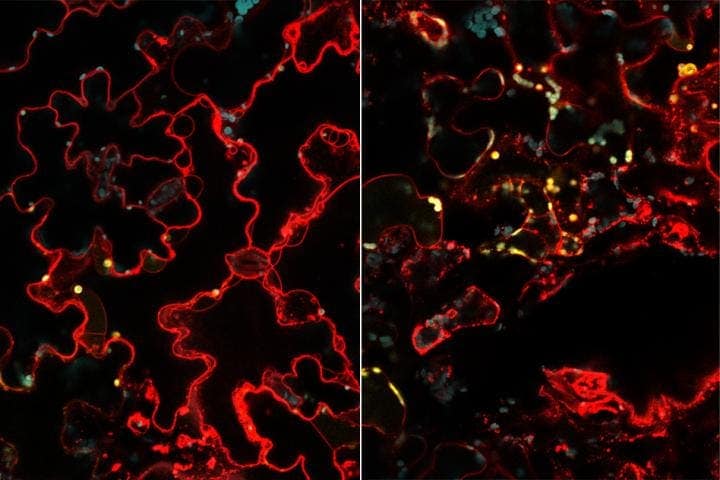
A new technique uses nanoparticles to deliver genes into the chloroplasts of plant cells, works with many different plant species. Credit: MIT.
Researchers at MIT sprayed tiny nanoparticles containing foreign genes into the chloroplasts of plant cells. The novel technique is an easier and less risky way to genetically modify plants, in contrast to established gene tools which can be expensive and cumbersome.
DNA delivery straight to the plant’s cell
The researchers, led by Michael Strano, who is a professor of chemical engineering at MIT, first learned that they could penetrate plant cell membranes with nanoparticles a few years ago. At the time, they found that if the size and electrical charge of the nanoparticles were just right — and every plant is different — they could then penetrate the plant cell’s membrane through a mechanism called lipid exchange envelope penetration (LEEP).
Previously, Strano and colleagues used this method to make plants grow by embedding luciferase, a light-emitting protein, into the leaves of a plant. But could genes be implanted in the same way? That’s what the research team set out to discover in their latest study published in Nature Nanotechnology.
“Bringing genetic tools to different parts of the plant is something that plant biologists are very interested in,” Strano says. “Every time I give a talk to a plant biology community, they ask if you could use this technique to deliver genes to the chloroplast.”
Chloroplasts are small organelles inside the cells of plants and algae, where sugar is made for fuel through photosynthesis. These tiny organelles contain about 80 genes, which code for proteins involved in photosynthesis.
Scientists had previously manipulated genes inside chloroplasts using a high-pressure technique called “gene gun”, however, this can result in damage to the plant and is not very effective.
First, the MIT researchers created nanoparticles consisting of carbon nanotubes wrapped in chitosan, which a naturally occurring sugar. They then added DNA whose negative charge allows it to easily bind to the positively charged nanotubes. The nanoparticle solution is then simply sprayed with a needleless syringe onto leaves, penetrating them through tiny pores called stomata, which typically regulate water evaporation.
The nanoparticles pass through the cell’s wall, membrane, ultimately penetrating the double membranes of the chloroplasts. Once inside, the slightly less acidic environment of the chloroplast causes the DNA to disentangle from the nanoparticles, which is now free to produce proteins.
As a demonstration, researchers used this technique to deliver a gene that codes for a yellow fluorescent protein in order to easily visualize the effectiveness of the process. They found that 47% of plant cells glowed in yellow, showing that the DNA producing the protein had been successfully delivered to the chloroplast. Researchers employed a variety of plants, including spinach, watercress, tobacco, arugula, and Arabidopsis thaliana. Virtually any kind of plant, including food crops, can be used. What’s more, different kinds of nanomaterials other than carbon nanotubes ought to work to produce similar results.
“This is a universal mechanism that works across plant species,” Strano said.
The technique could prove useful in engineering crops and vegetables with useful traits, such as drought and fungal resistance. And because the genes are carried only in the chloroplasts, they are only passed to offspring and not other plant species.
“That’s a big advantage, because if the pollen has a genetic modification, it can spread to weeds and you can make weeds that are resistant to herbicides and pesticides. Because the chloroplast is passed on maternally, it’s not passed through the pollen and there’s a higher level of gene containment,” Tedrick Thomas Salim Lew, MIT graduate student and co-author of the study, said.









